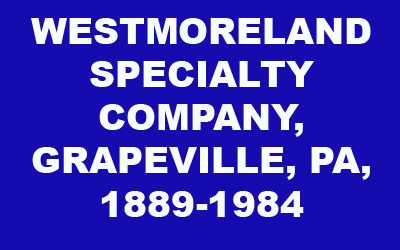|
 |
|
|
Glass Etch and Pattern Gallery
|
|
|
 |
|
|
|
|
|
|
|
|
|
|
|
|
|
Westmoreland Glass Company History

| Westmoreland Glass Company History |
Westmoreland Specialty Company (1889-1925), Westmoreland Glass Company (1925-1984), Grapeville, Pennsylvania.
In 1889, brothers Charles H. and George R. West, along with George M. Irwin purchased an abandoned glass factory that had briefly been home to the Liverpool Glass Works. Their early production consisted of commercial and novelty items such as candy containers, beer mugs, and jars. Many of the latter were filled with mustard and vinegar from the West Brothers? Grapeville Vinegar Works, which operated for a time on the same grounds. Eventually the vinegar and mustard business gave way to the expansion of the glass operation and by the mid-teens they were producing large quantities of high quality glassware, much of it offered with attractive cuttings or hand painted decorations, all done in Westmoreland?s own decorating department.
In 1921 Charles West took over as president when his brother left the company and James J. Brainard replaced Charles as treasurer. During this period many new colors, patterns, and decorations (including some beautiful copper wheel engravings) were introduced. However by the 1930s the Depression and foreign imports combined to drive the company deeply into debt. When Charles West resigned in 1937, turning the enterprise over to the Brainard family, several changes were immediately made to revive the ailing company. All colored glassware except milk glass was discontinued. Slow-moving or difficult-to-manufacture lines were dropped and ?new? patterns (many copied from 19th century designs) were introduced. Since they couldn?t compete with factories producing machine made glass, they promoted their wares as ?Authentic Handmade Reproductions.? Finally, the intricate and labor-intensive cuttings of the West era were drastically scaled back. By the mid-1940s these measures along with the halting of foreign imports due to WWII had returned the company to prosperity.
Customer demand for opal or milk glass grew rapidly after the war and Westmoreland was able to capture a large part of this market. In fact, at its peak in 1957, milk glass accounted for a whopping 95% of the company?s total output! This period would forever make the Westmoreland name synonymous with milk glass. But by 1960, sales were plummeting and it was decided that a return to transparent colors was needed to attract a new customer base. Their first attempt was a peachy-amber color called Golden Sunset. Unfortunately it didn?t sell well and despite its heavy promotion, it only lasted three years. Meanwhile, sales continued to slide with 1963?s output falling to half that of 1957. Eventually, other colors and decorations were introduced, some of which met with modest success, but the business never fully recovered and in 1980 a discouraged J. H. Brainard sold the company to David Grossman, a St. Louis based importer and distributor. Grossman took charge of Westmoreland in 1981 and a year later added some new colors and put some old molds back into production. Unfortunately this was not enough to jump-start the company and production ceased on January 8, 1984. Shortly thereafter, all remaining inventory was sold, along with the furniture, molds, catalogs, company records, even rolls of paper labels.
? From The Glass Candlestick Book, volume 3, by Tom Felt, Rich & Elaine Stoer (reprinted with permission) |
| Keywords: |
|
| Date: |
20.04.2007 23:10 |
| Hits: |
4368 |
| Added by: |
Tom Felt |
|
|

Powered by 4images 1.9
Copyright © 2002-2024 4homepages.de
Copyright © 2003 - 2019 Glass Etch and Pattern Gallery. All rights reserved, foreign and domestic.
|
|
|
|

